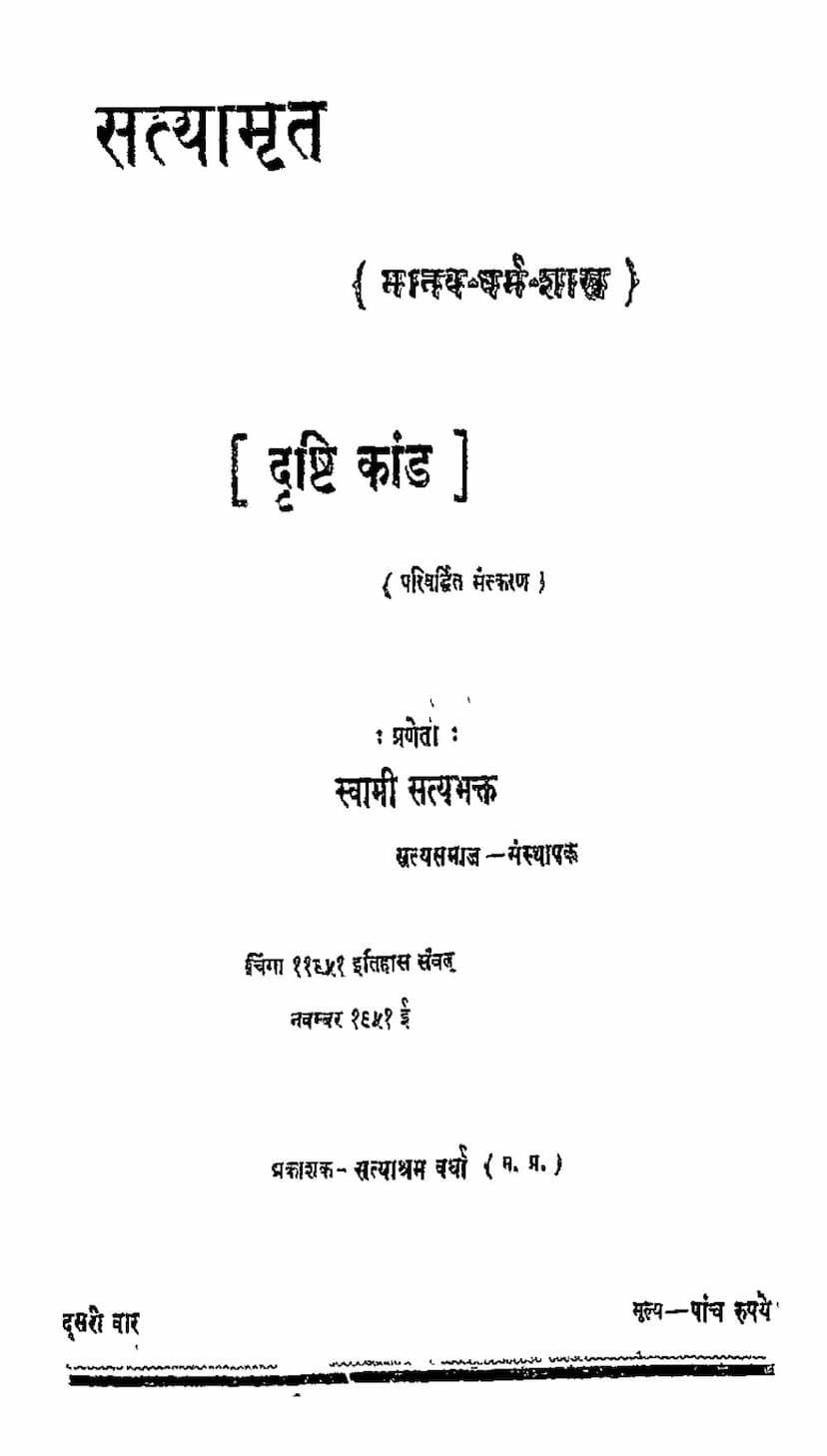Satyamrut Drhsuti Kand
Added to library: September 2, 2025

Summary
Here's a comprehensive summary of the Jain text "Satyamrut Drhsuti Kand" by Swami Satybhakt, based on the provided pages:
Book Title: Satyamrut (also known as Manav-Dharma-Shastra) Author: Swami Satybhakt (Founder of Satya Samaj) Publisher: Satyashram, Wardha Catalog Link: https://jainqq.org/explore/010834/1 Key Theme: This book, specifically the "Drhsuti Kand" (Vision Chapter), is presented as a foundational text for a universal human religion. It aims to provide a truthful and comprehensive vision of life, society, and spirituality, emphasizing universal principles over sectarian dogma.
Summary of the "Prastavika" (Preface) and Early Chapters:
The preface to Satyamrut, also called Manavdharma Shastra, highlights its core philosophy. Swami Satybhakt, the author, states that while respecting all scriptures, Satyamrut does not adhere to any single scripture as its sole foundation. Instead, it bases its principles on "Yug-Satya" (Truth of the Era) and a universal, timeless understanding of truth.
Key Principles Outlined in the Preface:
- Rejection of Scriptural Blindness (Shastra Moodhta): The book strongly opposes blind adherence to scriptures. The author emphasizes that the open world and one's own conscience (Vivek) are the greatest scriptures. Scriptures, including Satyamrut itself, are merely aids to understanding the grander "Mahashastra" of the world and the "Vivek Shastra" within us.
- Primacy of Truth over Scripture: If there's a conflict between truth and scripture, scripture should be sacrificed at the altar of truth, not the other way around. The author criticizes those who dismiss or distort scientific findings to fit ancient scriptures, calling it a sacrifice of truth.
- Universal Humanism: The title Manavdharma Shastra signifies its focus on humanity across all nations, races, and classes, without prioritizing any specific group.
- Pragmatic Universalism and Human Primacy: While acknowledging that the text prioritizes human welfare over that of other beings, the author clarifies this isn't due to bias. It stems from the natural law "Jivo Jivasya Jeevanam" (life sustains life) and the inherent understanding that minimizing harm is crucial. Given the inevitability of some violence for survival, Satyamrut advocates for minimizing it and basing it on sound principles. Since humans possess greater consciousness among known beings, their protection is prioritized, making this a practical approach to universal welfare. Those who ignore this practicality and demand absolute equality for all beings are seen as harboring delusion or self-deception.
- Structure of Satyamrut: The book is divided into three parts: Drishti Kand (Vision Chapter), Aadhar Kand (Foundation Chapter), and Vyavhar Kand (Conduct Chapter). Drishti Kand, the current volume, is the foundational one, offering a truthful perspective on various aspects of life, society, and religion.
- Second Edition (Parivardhan): The preface also details the significant expansions and improvements in the second edition, including providing human language equivalents for technical terms and substantially increasing the content in each chapter, making it almost double or more than double the original edition.
Key Themes and Concepts from the Early Chapters (as seen in the Table of Contents and early pages):
The Drishti Kand (Vision Chapter) delves into a wide array of subjects, aiming to provide a comprehensive understanding of truth and life. Key areas covered include:
- The Nature of Truth and God: The initial chapters explore the concept of "Satyadrishti" (Vision of Truth) and the nature of God. The author grapples with theistic and atheistic viewpoints, suggesting "Satyeshwar" (Lord of Truth) as a unifying concept encompassing both the material (Sat) and the conscious (Chit) and blissful (Anand) aspects of existence. This perspective aligns with scientific understanding while retaining a spiritual core.
- The Concept of "Satyeshwar": Satyeshwar is presented as the ultimate reality, the source of all, and the embodiment of truth, consciousness, and bliss. The text acknowledges the difficulty in fully comprehending such an entity, whether called God, Nature, or any other name, as it transcends ordinary perception and intellect. The effort to understand it, however, is deemed essential.
- Philosophical Debates: The book touches upon various philosophical concepts like "Ishwarvaad" (Theism), "Nirishwarvaad" (Atheism), "Mukitivad" (Liberation), "Dvaitadvaitvaad" (Dualism-Non-dualism), and "Nityanityavaad" (Eternal-Transient). It seeks to reconcile these differing perspectives through the lens of truth.
- Understanding Suffering and Happiness: A significant portion is dedicated to analyzing "Sukh-Dukh Vichar" (Thought on Happiness and Suffering). It categorizes physical and mental sufferings, exploring their sources and impact.
- The Vision of "Satyeshwar's Family": The text personifies virtues and principles as a divine family. "Satyeshwar" is the father, and figures like "Ahinsa" (non-violence) are his wife. Virtues like "Vivek" (conscience), "Sanyam" (restraint), "Dharmadev" (deity of duty), and "Gundev" (deity of goodness) are portrayed as their children, along with their respective consorts. This allegorical representation serves to explain abstract concepts in a relatable manner.
- The Importance of Observation and Discrimination (Drishti): The chapter emphasizes developing a clear, truthful vision by observing life, society, and spiritual principles without prejudice. It stresses the need for critical thinking and analysis to discern truth from falsehood.
- Principles of Knowledge and Action: The text discusses "Praman" (means of knowledge), "Tark" (logic), and "Anubhav" (experience) as tools for understanding truth. It highlights the use of scriptures and direct experience in guiding conduct.
- Ethical and Social Conduct: Themes like "Nishpakshata" (impartiality), "Parikshakta" (examiner's ability), "Samanvayashilta" (coordination/synthesis), and the understanding of "Sva-tva-moh" (attachment to one's own) and "Kaal-moh" (attachment to time) are explored as crucial for living a balanced and ethical life.
- The Path to Liberation and Peace: The concept of "Moksha" (liberation) and "Shanti" (peace) are discussed, along with the practices and virtues that lead to them.
Overall Significance:
Satyamrut, through its Drishti Kand, aims to provide a philosophical and ethical framework for a universal religion based on truth, reason, and pragmatic application. It encourages critical thinking, self-reflection, and a constant pursuit of truth, transcending the limitations of dogma and tradition. The author's emphasis on personal experience, universal principles, and the harmony between reason and emotion makes this text a significant contribution to Jain thought and broader spiritual philosophy.